Question:
How can I setup a workflow to use the DocuSign Signature Service?
Answer:
Please follow the instructions below to setup your DocuWare system to use the DocuSign Signature service.
Step 1: Register the organization with the DocuWare Signature Service.
Registering for a Production System
To register for a production token, a user must use this web page. They will be asked to log into DocuSign. They should use the credentials for the DocuSign account that they would like to enable our signature service to use to connect to DocuSign on their behalf.
Once the user has successfully logged into DocuSign, they will be redirected to our registration page. Here, they must enter their organization, DocuWare URL and provide a DocuWare user name and password. Additionally, they must provide a valid email address where they will be emailed the resulting token. They will see some information about their DocuSign account, including the subscription type and the ID of the user they logged in as in the previous step. If all information is correct, the registration will be completed and they will shortly receive an email with the token issued for their organization.
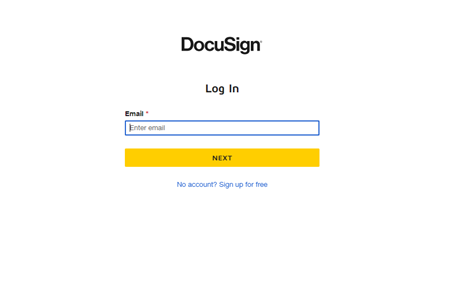
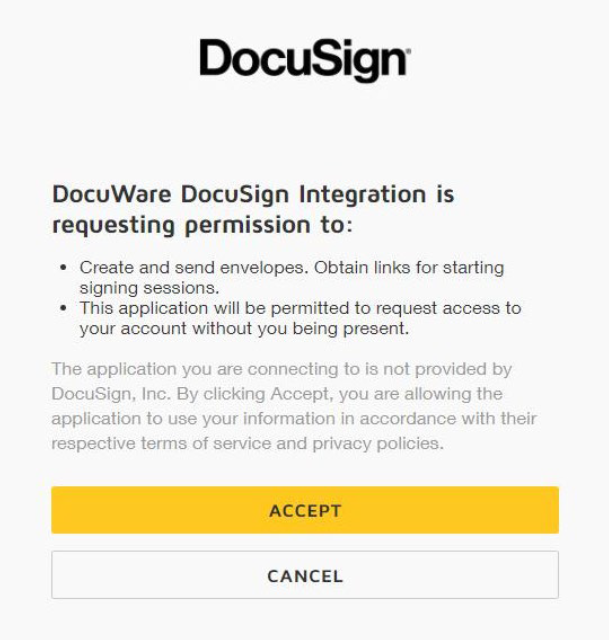
Successful login and acceptance of the request will grant the DocuWare Signature Service access to the customer’s DocuSign account and enable our service to send documents for signature as the user they provided at login.
There, they must enter their organization and DocuWare URL and provide a DocuWare username and password. Additionally, they must provide a valid email address where they will be emailed the resulting token. They will see some information about their DocuSign account, including the subscription type and the ID of the user they logged in as in the previous step. If all information is correct, the registration will be completed, and they will shortly receive an email with the token issued for their organization.
Step 2: Add DocuWare Signature Service as Web Service
Before configuring your workflow, you need to add DocuSign to the available web services in the DocuWare Configuration: https://signature.docuware.cloud/DocuSignSignatureService.svc 
Step 3: Configuring the signature workflow 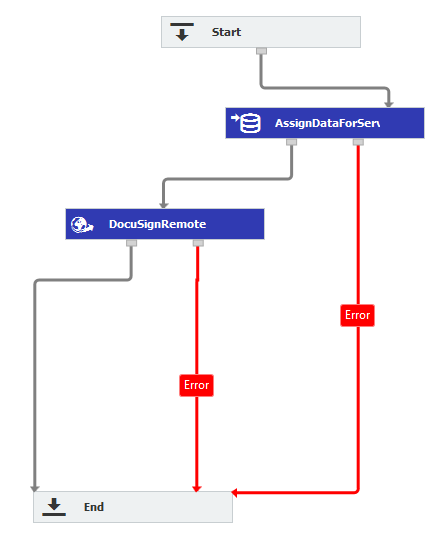
The following procedure describes how the document in the workflow is sent to DocuSign for signing and retrieved back:
- Trigger condition happens on a document.
- The DocuWare Signature Service only supports PDFs – the document is converted as needed.
- Document is sent to the DocuSign web application.
- The user opens an email and hits a button that sends them to DocuSign where they can review the document.
- The user may need to meet certain authentication requirements (Access Code, Phone, SMS or Knowledge Based Authentication), then they can sign the document.
- The DocuSign application calls our service and notifies DocuWare that the document was signed.
- DocuWare retrieves the document that has been updated with a signature, both in the metadata and by placing an image of the signature in a specific location of the document.
- The signed version of the document can either replace the original document or be clipped to the original document. In addition, an index field is updated with a specific value. This value can be a trigger condition for another workflow, for example.
The specifics of your workflow will depend on the needs of the use case you are fulfilling. Applying a signature to a workflow document requires two workflow activities – "Assign data" and "Web service".
Assign data
The first step is applying a workflow activity of the type “Assign data”. The purpose of this step is to create global variables for all the parameters and then assign pieces of data to them for use in calling the web service. It’s best practice to name the global variables the same as the parameter they are intended to represent.
For details and parameters, see the following.This is based on the AddNewDocumentRemote method:
- FileCabinetId (string) – GUID of the file cabinet with the document
- DocId (string) - ID of the document to be signed
- Token (string) – token received in the registration step that identifies the customer organization and provides user credentials
- SignerName – name of the person signing the document
- SignerEmail – email address of the signer of the document
- SectionNumber (int) – index of the section within the document to be signed
-1 indicates the last section found.
0 or 1 will be the first section.
An error will occur if a section is specified that doesn’t exist. - AnchorText (string) – This is the piece of text the service can look for on the document. If specified and not found, an error will occur. If not specified, then the subsequent location information will be absolute, rather than relative to finding a piece of text.
- AnchorTextOccurrence – Which occurrence of the anchor text should be used to be the starting location for placing the signature
-1 is the last occurrence.
0 or 1 is the first.
Any other number is a specific occurrence. - PageNumber (int) – page number within the file to start looking for the anchor text. -1 indicates to look on the last page. If no anchor text is specified, it is the absolute page number.
- SizeX (int) – size in millimeters of the width of the signature image
- SizeY (int) – size in millimeters of the height of the signature image
- PositionX (int) – Relative to the left side of the anchor text, this is the horizontal location of the signature image to be placed on the document (millimeters again). Positive numbers are to the right. Negative numbers are to the left.
- PositionY (int) – Relative to the top of the anchor text, this is the vertical location of the signature image to be placed on the document (millimeters again). Positive numbers are down. Negative numbers are up.
- SuccessStatusField (string) – This identifies a file cabinet field on the document that will be updated when a document is signed or rejected by the user in DocuSign.
- SuccessStatusValue (string) – This provides the value to be set in the above field when a document is signed.
- FailureStatusValue (string) – This provides a value to be set in the above field when a document is rejected by the user in DocuSign
- DateSignedFieldName (string) – This is an optional parameter that may be used to provide the name of a file cabinet field to hold the date the document was signed. When signed, we will update this field with the date it was signed by the user in DocuSign.
- PostSigningAction (string) – this specifies what is to be done with the signed document after the user signs it in DocuSign. The choices are “ClipBefore”, “ClipAfter” and “Replace”.
- IssuerName (string) – Display name used for the sender of the email and in the contents of the email message. If this value is left empty, it will default to the organization name.
- EmailSubject (string) – subject of the email
- EmailMessage (string) – text that is displayed in the contents of the email
- RecipientAuthenticationType (string) – This allows the workflow to specify what type of DocuSign authentication is required to allow a signer to sign a document. Valid values are “None”, “AccessCode”, ”Phone”, ”SMS”, ”KBA”
- SignerPhoneNumber (string) – phone number used for two-factor authentication (use international phone number format, ex. +18455639045) during the signing process. Required for SMS authentication.
- RecipientMayProvideNumber (Boolean) – Only for Phone authentication. If set to true, it ignores any value the user sets in the phone number. Then, at the time of signing the signer can provide the number to be called to receive the code by entering it in the DocuSign application.
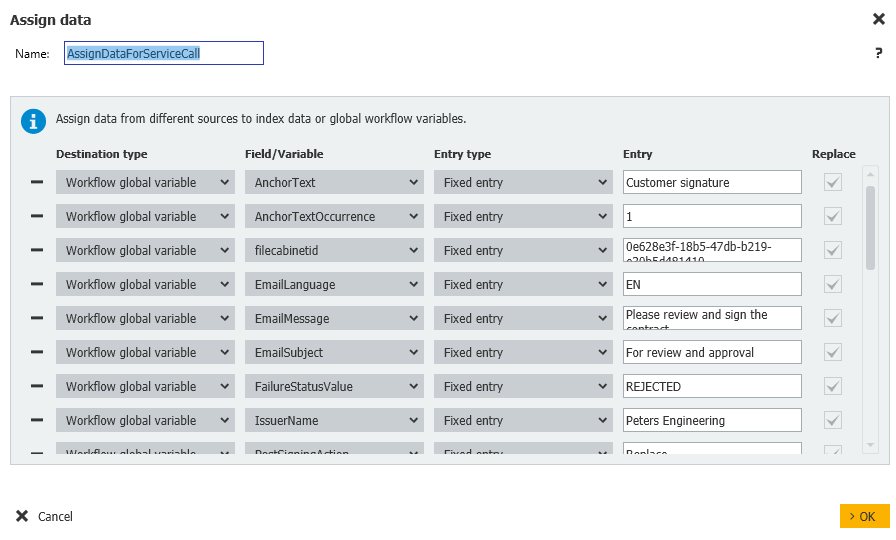
Select the web service in a Web Service activity. If you don’t see the signature service, configure it there and return to this step. Then, select the proper service method you wish to implement.
Now, in the parameters, select the global variables you created for each parameter. 

You may also choose to use the result parameters. These can be set to global variables and are used to decide the next step in your workflow. For example, if the web service's “Success” result (found in the success Boolean) is false, you may want to take a different path than if the result is true.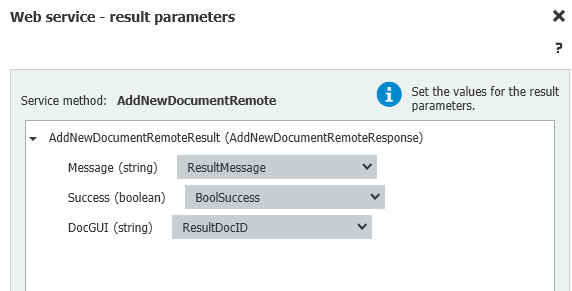
Once these changes have been made, please proceed to save and publish the workflow, then you'll be set to use the DocuSign Signature Service.
KBA is applicable to Cloud and On-Premise Organizations.


